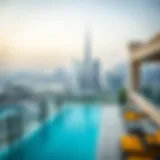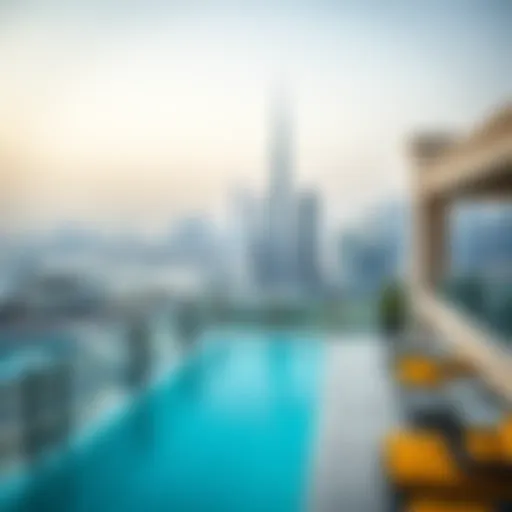Cycle Tracks in Dubai: An In-Depth Overview


Intro
Dubai’s bustling landscape, often recognized for its towering skyscrapers and luxury attractions, also hosts an emerging network of cycle tracks that are reshaping urban mobility. This extensive and thoughtfully designed infrastructure is more than just a green ribbon of bike paths snaking through the city; it marks a significant push towards sustainable transportation that’s gradually becoming a vital component of the city’s lifestyle. As urban planners place an increasing emphasis on integrating cycling routes into the fabric of this rapidly developing metropolis, it’s essential to delve into how these tracks are developed, their impact on real estate trends, and what the future holds for cycling in this sun-soaked city.
The burgeoning network of tracks is a direct response to rising demand for eco-friendly transport solutions. Cyclists are not only enjoying the health benefits that come with pedal power; they are also contributing to the reduction of carbon footprints. As vehicle congestion continues to plague urban areas, the necessity of cycling infrastructure gains traction, making it a hot topic among investors and planners alike.
It's crucial to understand the multifaceted role these cycle tracks play in influencing property trends and lifestyles within Dubai. From enhancing neighborhood livability to actively promoting community engagement, the cycle tracks propose a vision of urban development that places quality of life at the forefront. In this article, we’ll break down various aspects of cycling in Dubai—from understanding current property trends in relation to this cycling revolution to recognizing the avenues through which investment opportunities arise as a result.
Through a closer examination of incoming neighborhoods and market predictions, we'll uncover how the integration of cycle paths not only enriches the city’s aesthetic but also invites a dynamic shift in the real estate market. As we navigate this substantial transformation, the intertwined relationship between cycling infrastructure and property investment will come into sharper focus, underscoring why this topic is so pertinent to investors, homeowners, and planners.
Foreword to Cycling in Dubai
Cycling in Dubai is gaining prominence as a key component in the city’s evolving urban narrative. Historically, the idea of traversing the city on two wheels was often seen as a fringe activity, relegated to enthusiasts and the occasional daredevil. However, the recent push towards sustainable transport has placed cycling firmly in the spotlight. For investors, homeowners, and urban planners alike, understanding this shift is crucial, as it not only reflects a change in lifestyle but also presents new opportunities for investment and development.
The importance of cycling lies in its multifaceted benefits. Firstly, it serves as a sustainable mode of transportation, drastically reducing carbon footprints associated with conventional vehicles. With the region's population growing, and the roads becoming increasingly congested, cycling offers a clear alternative for commuting. Moreover, it encourages a healthier lifestyle by promoting physical activity among residents.
Another key aspect of cycling in Dubai is its potential to enhance community engagement. The establishment of well-designed cycle tracks facilitates social interaction and fosters a sense of community. Local events and organized rides become a platform for residents to connect, share experiences, and discover the beauty of the city's landscape from a new perspective.
Here are few key considerations regarding cycling in Dubai:
- Urban Development: As Dubai embraces a more cycle-friendly approach, urban planners are integrating bike lanes and tracks into the city’s infrastructure. This can increase property value in neighborhoods that prioritize bike access.
- Safety: Various safety measures are being implemented, including signage and dedicated bike paths, aimed at ensuring that both cyclists and pedestrians can coexist safely.
- Community Involvement: Engaging local residents in cycling events or forums helps create a sense of ownership and awareness about cycling’s benefits.
Cycling can reshape the urban landscape, turning it into a vibrant community hub rather than a simple corridor for cars.
Historical Context of Cycling Infrastructure
The development of cycling infrastructure in Dubai intertwines with the city's rapid evolution from a modest fishing and trading settlement to a global hub of innovation and tourism. Understanding this historical backdrop is key, as it lays the groundwork for current trends and future enhancements in the city’s cycling landscape. The journey begins with recognizing early inspirations and culminates in assessing modern strides that showcase Dubai's commitment to becoming a more biking-friendly metropolis.
Early Developments
In the early days, cycling was largely a leisure activity. The sandy terrains of Dubai did not initially favor biking. However, as urban growth surged during the late 20th century, the idea of cycling lanes began to take shape. Small, sporadic tracks were introduced, mainly around the iconic Dubai Creek area. Today, this area is imbued with a rich narrative, reflecting the blend of traditional lifestyle with modern aspirations. The introduction of these basic paths served a dual purpose: to promote healthy living and showcase the impending need for structured transport options in a burgeoning urban environment.
As cycling began to catch on, local charity events and weekend rides became popular, sparking community interest. These occasions built awareness, pushing the idea of a robust cycling infrastructure into the public discourse. The realization emerged that cycling could address both health and environmental concerns, ingraining itself into the city's urban planning discussions.
Recent Expansions
Fast forward to the present, and cycling in Dubai has experienced an explosive growth spurt. In recent decades, the government has invested substantially in developing extensive cycling networks. The Al Qudra Cycle Track, stretching over 86 kilometers, emerged as a remarkable flagship project demonstrating the extent of this commitment. This track, located in the desert, cleverly combines breathtaking views with accessibility, attracting both serious cyclists and casual riders.
In addition to Al Qudra, the establishment of bike-sharing schemes and rental stations across key locations signifies a dedicated approach towards accessibility. Cycle tracks in famous areas such as Dubai Marina and Jumeirah Corniche have been designed, blending seamlessly into the vibrant city atmosphere. The recent efforts emphasize not just the physical development of tracks but also fostering a culture that embraces cycling as a practical mode of transport.
“Creating cycling tracks isn’t just about infrastructure; it’s about envisioning a lifestyle where biking is seen as a mainstream option for every individual.”
This evolution culminates in a vision for a future where cycling is interwoven with daily life. With policies encouraging urban cycling initiatives, the city stands as a beacon for how historical contexts shape contemporary urban transport solutions. The strides made reflect profound changes in public attitudes and governmental priorities towards sustainable mobility.
Key Features of Cycle Tracks
As Dubai continues to evolve into a modern metropolis, the key features of its cycle tracks offer both functionality and aesthetic appeal. Among the numerous elements that contribute to this growing cycling infrastructure, design and materials, safety measures, as well as accessibility and connectivity play pivotal roles. Understanding these features is essential not only for cyclists but also for investors, urban planners, and developers who recognize the benefits of integrating cycling into the urban fabric.
Design and Materials
The design of cycle tracks in Dubai is no mere accident. Every curve and corner is carefully orchestrated, ensuring not just functionality for cyclists, but also harmony within the surrounding environment. Most tracks employ durable materials that withstand not only the wear and tear of tires but also the harsh climatic conditions prevalent in the desert. For example, asphalt surfaces are commonly used because they handle the heat well while providing a smooth riding experience.
Moreover, designs often incorporate elements that enhance usability. Segregated lanes for cyclists, pedestrian pathways, and spaces for landscaping help in creating a serene environment. Consider the cycling paths along the Dubai Marina, which not only emphasize safety through clear signaling but also enrich the riding experience with magnificent views of the towering cityscape.
Safety Measures
When discussing the feasibility of cycling in any urban setting, safety cannot be overlooked. In Dubai, cycling safety has been prioritized through various measures that aim to safeguard riders.
One of the significant approaches is the installation of dedicated bike lanes, ensuring that cyclists have a clear and protected space away from vehicular traffic. These lanes are often marked with bright, attention-grabbing colors and symbols to provide high visibility and further enhance safety. Moreover, traffic signals tailored for cyclists can be found at various intersections, allowing for a safer transition across roadways.
Another key initiative is the increased presence of law enforcement during popular cycling events, which not only deters reckless driving but also builds community trust. Bike-sharing programs also promote safety by providing helmets and safety gear, ensuring every rider is well-equipped before hitting the tracks.
"The design and operational efforts of Dubai's cycling infrastructure not only cater to current users but also lay the groundwork for future generations."
Accessibility and Connectivity
A paramount feature of any cycle track is its accessibility and connectivity, both of which play crucial roles in encouraging cycling as a viable mode of transport. The cycle tracks in Dubai have been strategically planned to connect major neighborhoods, business districts, and leisure zones.
For instance, the Al Qudra Cycle Track is particularly notable for its extensive network of paths that link diverse communities. It's common for people to ride to work or enjoy leisurely weekends on these tracks, avoiding the usual hassle of traffic jams.
Furthermore, facilities like bike racks at public transport stations ensure that riders can easily switch between cycling and using public transport. This seamless integration not only enhances the user experience but also contributes to reducing the carbon footprint of the city as more individuals opt for cycling as part of their daily commute.
In summary, the design and materials, safety measures, as well as the accessibility and connectivity of cycling tracks in Dubai present a well-rounded infrastructure that promotes the welfare of cyclists while making significant contributions to the urban landscape. As these features continue to evolve, they pave the way for a future that embraces greener and healthier living.
Popular Cycling Routes
The cycling landscape in Dubai isn’t just about the tracks; it’s also about the routes that them give character and purpose. Popular cycling routes in this vibrant city symbolize a blend of urban life and scenic beauty. Each track offers a unique experience, showing off Dubai’s commitment to sustainable transportation and healthy living. As cycling gains traction as a favored activity among locals and tourists alike, understanding these routes is crucial for investors, developers, and urban planners who recognize the potential impact on property values and community engagement.
Dubai Marina Cyclists’ Haven
Nestled along the breathtaking coastline, the Dubai Marina offers a dedicated cycling route that has become a hub for enthusiasts. This track stretches for several kilometers, bordering the glistening waters and flanked by some of the most stunning skyscrapers. The architectural backdrop alone - with iconic buildings like the Cayan Tower and the Address Dubai Marina - enhances the cycling experience.
Here, pedestrians and cyclists mix, creating a lively atmosphere brimming with energy. The path is well-lit, equipped with resting spots, and lush greenery that adds to the scenic feel. Not to mention, the proximity to cafes and restaurants provides an excellent incentive for those looking to pedal their way to a refreshing drink or a hearty meal post-ride.
Advantages of this route include:
- Accessibility: Easily reachable by the metro or car, making it a favorite for city dwellers and tourists alike.
- Variety of Amenities: Lavish security measures and well-maintained facilities cater to all ages and skill levels, thus encouraging more people to embrace cycling.
- Community Engagement: With frequent events organized along this path, it fosters a sense of community among riders, enhancing social interactions.
"Cycling in Dubai Marina is not just a hobby; it’s an experience that combines fitness with the stunning backdrop of luxury living."
Al Qudra Cycle Track
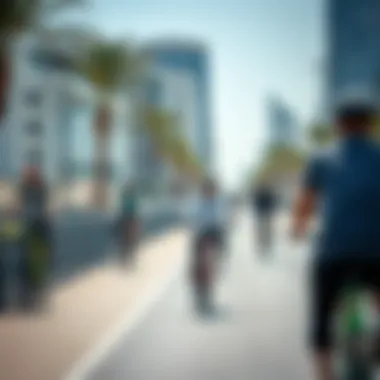
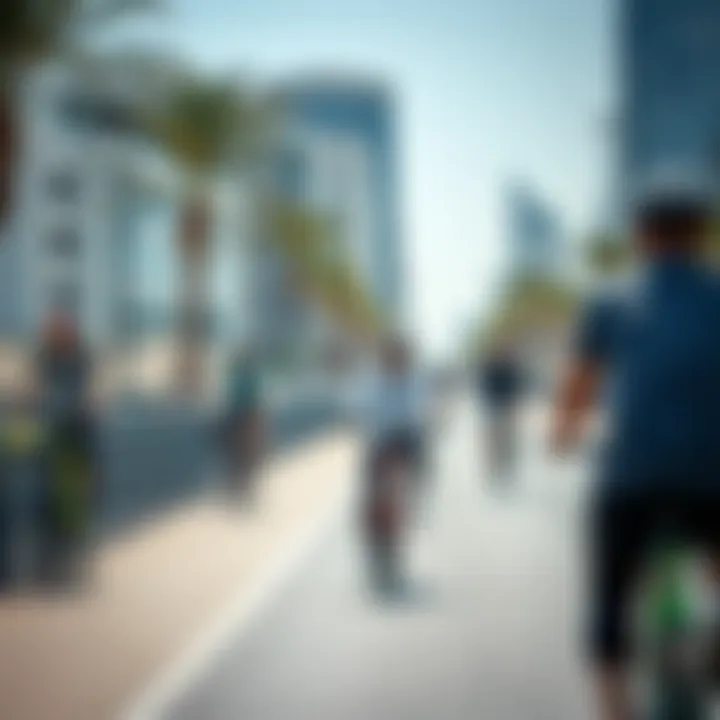
On the flip side, the Al Qudra Cycle Track offers a completely different vibe. Located in the desert outskirts of Dubai, this route stretches approximately 86 kilometers, attracting both serious athletes and casual cyclists. The path winds through the serene landscape, away from the hustle and bustle of urban life. Riders can indulge in the tranquility of nature, with picturesque views of sand dunes and the occasional sighting of local wildlife, like Oryx and various bird species, making it a unique ride.
This track is marked architecturally minimal, yet it’s equipped with essential amenities such as rest areas, water stations, and even a family-friendly biking section. Riders often praise Al Qudra for its potential to challenge their endurance while simultaneously allowing them to immerse themselves in the peacefulness of the desert.
Key features of Al Qudra include:
- Flexible Lengths: Cyclists can choose to ride shorter distances or tackle the full stretch, accommodating all types of riders.
- Stargazing Opportunities: Given the absence of city lights, night rides allow for spectacular views of the stars, adding to the allure of this cycling haven.
- Environmental Appreciation: The landscape promotes an appreciation for the natural world, which can foster a greater commitment to sustainability.
Jumeirah Corniche Paths
Lastly, the Jumeirah Corniche Paths offer a leisurely cycling experience along the coast. This route, not only scenic but also strategically designed to connect various neighborhoods, makes it perfect for both leisure and commuting. With views of the iconic Burj Al Arab, the path encourages cyclists to enjoy their ride while soaking in the stunning surroundings.
The Jumeirah waterfront is a lively segment of Dubai, where cyclists can blend in with joggers and walkers, creating a vibrant community vibe. The Corniche is also equipped with shared facilities, making it an ideal spot for families and individuals looking to integrate cycling into their daily lives.
Highlights of the Jumeirah Corniche include:
- User-Friendly Layout: Designed with wide lanes, it promotes safe cycling while accommodating higher volumes of foot and bike traffic.
- Proximity to Attractions: With multiple access points to beaches, parks, and restaurants, this route serves as a hub for social activity.
- Community Events: It's not unusual to find community gatherings, fitness activities, or pop-up markets along this route, fostering local engagement.
In essence, the popular cycling routes in Dubai are not merely tracks; they are essential components of the urban fabric. Each one offers unique experiences that not only encourages healthy lifestyles but also supports community ties and economic growth. As Dubai continues to develop its cycling infrastructure, these routes exemplify the city's commitment to enhancing the quality of life for its residents and visitors alike.
Cycling Events and Community Engagement
The integration of cycling events and community engagement in Dubai serves as a linchpin in fostering a vibrant cycling culture. With a landscape designed for active lifestyles, these events not only cultivate camaraderie among cyclists but also serve as pivotal avenues for promoting cycling safety and awareness. As the city embraces its position as a premier destination for both residents and tourists, the emphasis on community-centric cycling initiatives grows ever more significant.
Regular Community Rides
Regular community rides in Dubai act as a cornerstone for building a strong network among cyclists. These are often organized by local clubs or community groups that encourage riders of all skill levels to participate. The rides can vary in length and intensity, catering to families, leisure riders, and seasoned cyclists alike.
The charm of these events lies in their informal yet purposeful atmosphere. Engaging in a community ride offers participants a social connection with fellow cycling enthusiasts. The feeling of shared achievement as participants traverse scenic routes like Dubai Marina and Jumeirah Corniche cannot be overstated. Each ride not only promotes fitness but also highlights the city's commitment to Sustainability and wellness.
Moreover, community rides often come equipped with safety briefings and support assistance, ensuring that even novice cyclists feel confident on the road. Local businesses sometimes participate, offering sponsorships or post-ride refreshments, which helps in cultivating a local cycling ecosystem.
Cycling Competitions
Cycling competitions in Dubai present an exhilarating platform for athletes to showcase their talents. These events vary from local criteriums to larger-scale races that can attract international participants. With tracks like the Al Qudra Cycle Track serving as popular venues, these competitions amplify the city's allure as a destination for cycling sports.
Competitions contribute to cycling's visibility within the broader community and encourage skills development among participants. For many, these events are not solely a test of speed and endurance but also offer an opportunity to network and learn from seasoned cyclists. The prizes can often range from cash rewards to valuable sponsorships, adding to the thrill.
"Through competitions, we not only promote cycling but also encourage engagement with an audience that appreciates health, fitness, and community spirit."
Finale
In summary, the keen focus on cycling events and community engagement is integral to promoting a cycling-friendly culture in Dubai. Whether through relaxed community rides or high-stakes competitions, these activities serve as vital touchpoints that enhance the city’s cycling narrative. By marrying fun with fitness and community spirit, Dubai continues to carve out its identity as an international cycling hub.
Challenges Facing Cyclists
Cycling in Dubai, while offering a plethora of advantages, does not come without its hurdles. Understanding these challenges is crucial for investors, urban planners, and cyclists alike. Identifying the obstacles makes it easier to navigate through them and work towards creating a more cyclist-friendly environment. Challenges such as traffic congestion, urban planning issues, and extreme weather conditions require immediate attention. Addressing these factors not only enhances the cyclist's experience but also fosters a safer and more accessible urban landscape for everyone.
Traffic and Urban Planning Issues
Traffic congestion is a prominent issue confronting cyclists in Dubai. The rapid urbanization of the city has led to an increased volume of vehicles on the roads, often resulting in gridlock. This situation can be perilous for cyclists, as they find themselves navigating through congested areas where vehicles dominate the space. Moreover, urban planning has historically prioritized cars over cyclists, which exacerbates the problem. Cycle tracks may suddenly end or not connect well with key locations, forcing cyclists to share the road with cars, a scenario fraught with potential danger.
Some key factors that capture these issues include:
- Infrastructural Gaps: Many routes lack proper signage or clear demarcation, making it difficult for cyclists to know where they can legally or safely ride.
- Mixed-Use Paths: Confusing shared paths that cater to both pedestrians and cyclists can create friction among users, often leading to accidents.
- Limited Connectivity: Not all popular destinations are easily reachable by cycle tracks, which may discourage potential cyclists from utilizing this mode of transport.
Addressing these challenges requires strategic urban planning that prioritizes safety and accessibility for cyclists. Investment in infrastructure, like dedicated bike lanes, is crucial. This isn’t just about building tracks; it’s about designing a comprehensive cycling ecosystem that connects all parts of the city harmoniously.
Weather Considerations
Another challenge significantly impacting cyclists in Dubai is the extreme weather, especially during the summer months. Temperatures soar above 40 degrees Celsius, making outdoor activities not just uncomfortable but potentially dangerous. This harsh environment can deter even the most avid cyclists from using the cycle tracks as intended.
Some considerations include:
- Heat-Related Risks: Prolonged exposure to such high temperatures can lead to dehydration or heat exhaustion, which are serious concerns for cyclists who may underestimate their body's limits.
- Dust Storms: Sudden dust storms can obscure visibility and create hazardous conditions. This is a frequent occurrence in the desert environment of Dubai.
- Seasonal Fluctuations: While summer heats can drive people indoors, the milder months might not see enough infrastructure in place to promote cycling as a primary means of transport.
To combat these weather-related challenges, innovative solutions are needed, such as shading structures along tracks or providing resources like hydration stations. Encouraging cycling during cooler parts of the day can be another way to promote safer riding conditions.
Overall, these challenges underscore the need for a concerted effort in both urban design and community engagement. A successful cycling culture in Dubai hinges on addressing these issues head-on, creating an environment where cycling can truly thrive and be embraced by residents and visitors alike.
The Benefits of Cycling in Dubai
Cycling in Dubai is more than just a leisurely activity; it’s a pathway to a healthier, more sustainable lifestyle. As the city grows and urbanizes at a brisk pace, the significance of cycling continues to gain traction. Not only does riding a bike contribute positively to personal health, but it also provides a myriad of environmental and economic benefits, aligning well with the city's ambitions for sustainable urban development.
Health Advantages
Engaging in cycling can be a game-changer for physical well-being. Here’s why:
- Physical Fitness: Cycles offer a fantastic cardio workout. Regular cycling can improve cardiovascular health, develop muscle strength, and enhance endurance. It’s been shown to reduce the risk of obesity and related diseases.
- Mental Health Boost: Cycling is known to release endorphins, which can help alleviate stress. In a bustling metropolis like Dubai, having a mental health outlet is key. Cyclists often report feeling more energetic and happier after riding, which can be attributed to both the exercise and the exposure to the outdoors.
- Social Connections: Many community rides bring people together, fostering friendships among locals and expats. When cyclists team up for events or casual weekend rides on the cycle tracks, it’s a way to build social fabric in a diverse city.
Environmental Impact
Riding a bike as a means of transportation can significantly reduce the carbon footprint. Here are some ways cycling benefits the environment:
- Reduction in Emissions: In a city known for its relentless traffic congestion, cycling lessens the reliance on cars, which ultimately translates to a reduction in greenhouse gases. According to recent studies, if more people opted to cycle, overall vehicle emissions could drop dramatically.
- Less Noise Pollution: Bicycles are naturally quieter than cars. The more cyclists there are on the roads, the more vibrant and tranquil the urban soundscape becomes.
- Urban Greenery: Cities that promote cycling tend to invest in green spaces along cycling routes. This not only beautifies the area but also supports biodiversity, making urban environments more hospitable for various flora and fauna.
Economic Effects
The economic benefits of cycling in Dubai extend beyond the individual cyclist; it contributes to the city’s economy at large.
- Tourism Growth: Cycling is increasingly becoming a tourist attraction. Visitors are drawn to the cycling culture, enhancing Dubai’s reputation as a vibrant city. Folks come from far and wide to explore the scenic routes alongside the city's iconic skyline.
- Impact on Local Businesses: When cyclists frequent an area, local shops and cafés often see a boost in traffic. Amenities that cater to cyclists—like bike rentals and maintenance shops—can thrive in neighborhoods with good cycle infrastructure.
- Infrastructure Investments: Developing cycling paths leads to job creation, both in construction and ongoing maintenance, providing a boost to the local job market.
"Investing in cycling infrastructure is not only an investment in health but also in the economy."
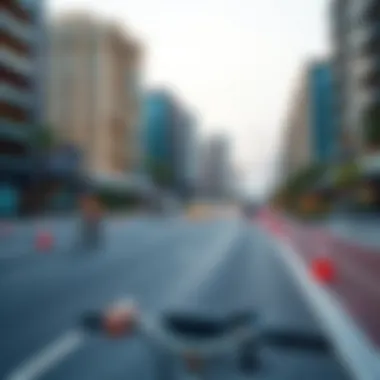

As Dubai continues to evolve as a modern metropolis, the integration of cycling as a core activity symbolizes a thoughtful approach to urban planning. The benefits are substantial, touching on health, environmental sustainability, and economic vitality, making cycling a pivotal aspect of Dubai's urban landscape.
Integrating Cycling into Real Estate Developments
As cities evolve, the integration of cycling paths into real estate development has become increasingly relevant, particularly in a rapidly growing urban environment like Dubai. By incorporating well-planned cycling infrastructure into residential and commercial projects, developers can harness several benefits, ranging from attracting new investors to increasing the overall property value. This article aims to underscore the importance of these developments and their impact on urban living experiences, health, and sustainability.
Attracting Investors with Cycling Infrastructure
When developers thoughtfully incorporate cycling tracks into their projects, they’re not just improving accessibility for cyclists; they’re sending a strong signal to potential investors. A well-designed cycling network means enhanced connectivity to local stores, parks, and community hubs. This connectivity becomes a significant selling point, appealing to people who prioritize health, wellness, and convenience.
To give you an idea of this approach, consider a project that integrates cycling tracks with easy access to public transport and essential services. If you can cycle to work or the nearest grocery store, that’s an attractive prospect for many prospective buyers who might shy away from car-dependent areas.
Here are some specific benefits that entice investors:
- Market Demand: There's a growing appetite for properties that promote active lifestyles and sustainability.
- Long-Term Viability: Investments today can lead to higher returns in tomorrow's eco-conscious market.
- Community Building: An engaged community creates a vibrant atmosphere, increasing desirability for potential tenants and buyers.
Enhancing Property Value
The value of a property is often tied to its location and the amenities it offers. By integrating robust cycling infrastructure, developers can significantly enhance property value. When a neighborhood boasts well-maintained, easily accessible cycling tracks, it makes for a more desirable living environment. In Dubai, where urban sprawl often dictates living conditions, easy cycling routes can ease commuting burdens, making homes more attractive.
Consider this: a well-connected cycling path can elevate a property's status from merely livable to highly coveted. Homebuyers increasingly see cycling as not just a form of exercise, but as a convenient, eco-friendly transport option.
Some key points to consider regarding property value include:
- Higher Selling Prices: Properties close to cycling paths may fetch higher sale prices compared to those in areas with limited cycling access.
- Increased Rental Demand: As preference among renters shifts towards healthy living, properties with cycling access become more sought after.
- Long-Term Appreciation: Areas with cycling-friendly infrastructure often experience greater appreciation over time, providing a win-win for investors.
"Incorporating cycling paths into real estate not only fosters an active lifestyle but also creates a sense of community among residents, enhancing overall living quality."
Integrating cycling into real estate developments is not merely a trend but a functional strategy addressing urban mobility, contributing to healthier citizens, and ultimately creating lasting value in a fast-paced metropolis like Dubai.
The Role of Technology in Cycling
In an age where technology intertwines with our daily routines, its role in cycling cannot be understated. Innovations have transformed the cycling experience, propelling it from a simple mode of transport to a multifaceted activity that encompasses fitness tracking, safety enhancements, and improved navigation. For investors, developers, and urban planners, recognizing the technological developments influencing cycling can provide insights into consumer behaviors and preferences.
Smart Cycling Solutions
Smart cycling solutions encompass a range of advanced technologies tailored to enhance cyclists' safety and convenience. Among these solutions, connected bike systems stand out. These systems integrate GPS tracking, smart locks, and data analytics to offer cyclists real-time insights into their journeys. For instance, a smart bike equipped with a GPS device can alert users to safe cycling routes, current traffic conditions, and even nearby bike repair services.
Furthermore, the role of sensors in bicycles has expanded. Sensors can monitor tire pressure, cadence, and even the rider’s heart rate, delivering real-time data straight to an accompanying mobile app. This information allows users to tailor their rides, ensuring both performance and safety. Implementing such technology not only benefits individual cyclists but can also enhance the city’s cycling infrastructure by providing valuable usage data.
Key Features of Smart Cycling Solutions:
- GPS Tracking: Helps in avoiding traffic congestions and identifying optimal cycling paths.
- Safety Alerts: Instant notifications about approaching vehicles or dangerous conditions.
- Performance Monitoring: Tracks fitness metrics like speed, distance, and heart rate for improving cycling efficiency.
- Maintenance Notifications: Reminds cyclists about necessary bike servicing based on usage patterns.
The significance of smart cycling solutions in Dubai cannot be ignored, especially given the city's commitment to becoming a bicycle-friendly metropolis. By merging technology with cycling, urban planners can design more effective infrastructures, thus promoting cycling as a lasting transportation option.
Apps for Cyclists
With the proliferation of smartphones, apps have emerged as powerful tools for cyclists. These applications bridge the gap between cyclists and the urban landscape, offering features tailored to enhance cycling experiences. For instance, Strava and MapMyRide are popular among avid riders, enabling them to track routes, analyze performance data, and even share experiences with fellow cyclists.
Additionally, navigation apps specifically designed for cyclists can significantly enhance the riding experience. Such apps account for factors such as bike lanes, road conditions, and safety zones, enabling cyclists to plan their journeys with greater efficiency. Users can also find local cycling events and connect with other riders through community features embedded within these applications.
Benefits of Cycling Apps:
- Route Planning: Highlights bike-friendly paths and avoids high-traffic zones.
- Community Engagement: Enables users to join local cycling groups or events promoting a sense of camaraderie.
- Performance Insights: Provides analysis and metrics that help cyclists monitor improvements.
- Safety Features: Some apps offer location sharing for safety during rides, especially for long-distance cyclists.
In summation, the role of technology in cycling—be it through smart solutions or mobile applications—significantly enhances the overall experience. Urban planners and investors should pay attention to these trends as it indicates not only a shift in how biking is perceived but also a clear direction towards a more integrated and cycling-friendly Dubai.
Looking Ahead: Future of Cycling in Dubai
As Dubai advances in its goals of sustainability and mobility, the future of cycling presents an exciting frontier. The enhanced integration of cycling into the city's urban fabric is not merely a trend; it’s a vital part of overcoming challenges such as traffic congestion and environmental impact. This section sheds light on what lies ahead as cycling gains footing in Dubai's transportation landscape.
Upcoming Projects
A pivotal aspect shaping the future of cycling tracks in Dubai involves a series of ambitious projects that aim to expand infrastructure and improve accessibility. With the local government's vision to create a comprehensive cycling network, some notable upcoming projects include:
- The Al Qudra Extension: This project plans to extend the well-loved Al Qudra cycle track, promoting longer rides in a picturesque desert landscape. It aims to enhance the route's safety and add more facilities for cyclists.
- Dubai Marina Cycle Track Enhancement: Upgrades to the Dubai Marina area promise to improve the cycling experience with better signage and dedicated lanes separated from pedestrian paths to ensure cyclist safety.
- Community Cycling Hub Developments: New hubs are in the pipeline to facilitate community engagement by offering resources and spaces for cyclists to connect and share their experiences.
These projects are designed with the primary aim of making cycling safer, more enjoyable, and more accessible to residents and visitors alike.
Vision for Sustainable Mobility
The vision for sustainable mobility in Dubai is interwoven with the promotion of cycling as a key component. Embracing cycling aligns with broader city objectives focused on reducing carbon emissions and improving residents’ quality of life. The focus is on:
- Reducing Traffic Congestion: By fostering a reliable cycling culture, Dubai aims to alleviate the stress on road networks. Encouraging more people to choose bicycles over cars has the potential to significantly lessen traffic delays.
- Promoting Health and Wellness: Urban planners understand that cycling encourages an active lifestyle, leading to healthier communities. Public health initiatives are more likely to take hold in areas that champion cycling as a viable transportation mode.
- Enhancing Air Quality: Shifting traffic patterns by increasing cycling numbers can contribute to cleaner air, as fewer vehicles on the road mean reduced emissions.
"A city that invests in cycling infrastructure is, in turn, investing in the health of its citizens and the future of urban living."
Achieving this vision necessitates collaboration between various stakeholders, including local governments, cycle advocacy groups, and private citizens. By building a robust framework for cycling, Dubai can strive toward its ambitious goals of sustainability and livability well into the future.
Comparison with Other Global Cities
When examining cycling infrastructure, it’s crucial to compare how different cities around the world approach the integration of bicycles into everyday urban life. In the context of Dubai, such comparisons not only shine a light on the existing efforts but also highlight potential areas for improvement. Understanding what works in other metropolises can provide valuable insights into how Dubai can further develop its cycling tracks and promote cycling as a preferred mode of transport.
Cycling Friendliness
Cycling friendliness refers to the overall environment that supports cyclists, which includes not just the existence of dedicated bike lanes, but also facilities and policies that make cycling a viable alternative to driving. Cities like Amsterdam and Copenhagen are often hailed as paragons of cycling culture. These cities have invested heavily in extensive bike lanes, parking areas, and integration with public transport. For instance, Amsterdam boasts more bicycles than residents, thanks to its well-planned cycling routes that ensure safety and convenience.
In contrast, Dubai is still catching up. While significant strides have been made since the development of its dedicated cycle tracks, the cycling experience can vary dramatically based on the area. For example, spots like Dubai Marina and Jumeirah have seen considerable cyclist traffic thanks to their picturesque waterfront paths, an array of amenities, and an active cycling community. However, other parts of the city still lack the infrastructure needed to encourage cycling. This uneven distribution can discourage potential cyclists.
While Dubai emerges on the global cycling scene, policies that reinforce cycling goals—such as restrictions on parking for cars in favor of bike-friendly zones—could boost its status as a friendly environment for cyclists. Ultimately, creating a culture that embraces cycling requires not just physical infrastructures, like cycle tracks, but also a social awareness that values sustainable transport methods.
Best Practices
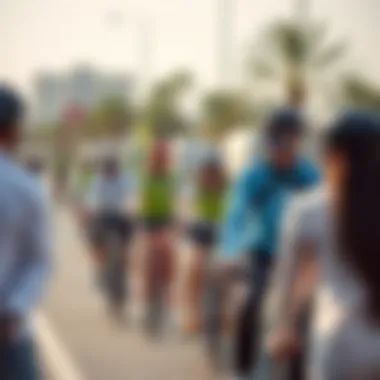
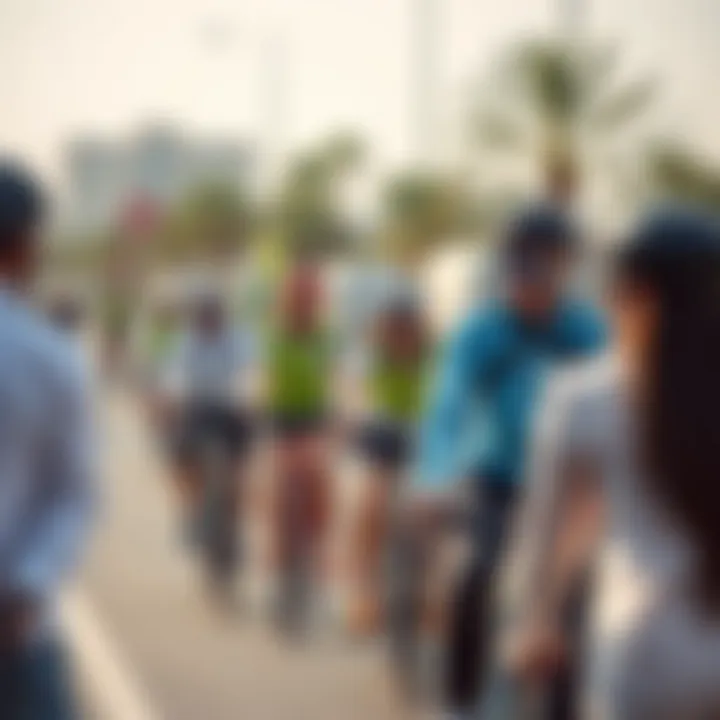
To streamline the development of cycling infrastructure in Dubai, learning from the best practices of global cities is essential. Here are key elements worth emulating:
- Dedicated Cycle Lanes: Just like in cities such as Copenhagen, Dubai benefits from planning bike lanes separated from vehicle traffic to enhance safety.
- Comprehensive Bicycle Sharing Programs: The introduction of bike-sharing systems similar to those in Paris can encourage casual riders while making cycling accessible for tourists.
- Urban Planning Integration: Integrating cycling routes with residential and commercial developments, akin to Singapore's model, ensures that cyclists can easily commute to work or leisure spots without relying heavily on cars.
- Community Engagement: Regular events and community rides in places like Toronto help foster a culture around cycling. Dubai's local councils could adopt similar strategies to build a community among cyclists.
- Access to Amenities: Establishing bike repair stations, rest areas, and connections to public transport can significantly enhance the cyclist's experience. Cities like Berlin often showcase how a supportive cycle environment contributes to a more vibrant, healthy community.
By drawing from these best practices, Dubai can not only cultivate a cycling culture but can also position itself as a leading city in promoting environmentally-friendly transport options.
"Cities that prioritize cycling infrastructure not only enhance the quality of life for their residents but also pave the way for sustainable urban growth."
As cycling becomes an integral part of Dubai's urban planning and lifestyle, the importance of these comparisons with global counterparts will only grow. Not only will such actions likely create a healthier city, but they could also open doors for economic opportunities through cycling tourism and enhanced community interaction.
For further reading on global cycling trends, visit Wikipedia.
Economic Contributions of Cycling Tourism
Cycling tourism in Dubai is not just a leisure activity; it has burgeoned into a pivotal component of the city's economy. As travelers seek healthier, environmentally conscious ways to explore urban environments, the opportunity for Dubai to harness this trend is substantial. Investing in cycling infrastructure isn't merely about providing paths; it reflects a commitment to enhancing the overall tourism experience while simultaneously stimulating local economic growth.
Cycling fosters a unique interaction with the city, allowing tourists to appreciate the sights at their own pace and in a more personal manner.
Cycling as a Tourist Attraction
The rise of cycling as a tourist attraction in Dubai can be attributed to several factors. First, the city's picturesque landscapes lend themselves beautifully to cycling routes. Imagine pedaling along the stunning waterfront in Dubai Marina or cruising through the serene Al Qudra desert paths. Each ride not only offers exercise but also immerses visitors in breathtaking surroundings. The popularity of events like the Dubai Ride showcases that there's a captive market eager to participate.
Moreover, the experience is enriched through guided tours led by local experts. These tours often combine cycling with cultural education, giving tourists insights into the history and lifestyle of Dubai. This connection to local culture enhances the attractiveness of cycling as more than just a fitness activity—it's about community engagement and education.
Cities that adopt cycling-friendly tourism often see an influx of visitors willing to spend money on bike rentals, specialized tours, and even local eateries that cater specifically to an active crowd. Consequently, this creates a ripple effect; local businesses thrive, contributing to further local employment opportunities.
Partnerships with Local Businesses
Creating a booming cycling tourism economy in Dubai hinges significantly on partnerships with local businesses. Bike rental shops, cafes, and even hotels can benefit mutually from promoting cycling tourism. When hotels offer bicycle rentals or services that cater to cyclists, they distinguish themselves in a competitive market. Visitors may choose accommodations based on their cycling capabilities, thus linking tourism directly to real estate and hospitality development.
Additionally, collaborating with local eateries can lead to curated menus designed for cyclists, complete with energy-boosting options and hydration stations along popular routes.
- Bike shops can provide necessary gear and maintenance services, creating a hub for cyclists to gather.
- Eateries can highlight healthy dining options tailored for cyclists, making them ideal stops along cycling routes.
The potential for growth through these partnerships is profound. As businesses collaborate to promote cycling events or participate in cycling festivals, they not only boost their visibility but also solidify a cycling-friendly brand image in Dubai. This not only enhances the visitor experience but also leads to increased spending in the local economy, fostering a vibrant cycling culture.
Cycling Regulations and Policies
Regulations and policies surrounding cycling in Dubai are critical for shaping a safe and enjoyable experience for both cyclists and other road users. They serve as a foundation for developing a cyclist-friendly infrastructure, which plays a significant role in encouraging more residents to choose bikes over cars. An organized approach to regulations helps to reduce accidents, promote responsible riding, and enhance the overall perception of cycling as a viable mode of transport within the city.
Local Government Initiatives
The local government has taken numerous steps to advance cycling regulations. These initiatives aim to integrate cycling into the wider urban transport framework. Here are some key points highlighting the local government's contributions:
- Dedicated Cycling Paths: One of the significant strides has been the establishment of designated lanes specifically for cyclists. These paths ensure that cyclists can ride safely away from vehicular traffic, which decreases the likelihood of accidents.
- Awareness Campaigns: The government has launched public service campaigns informing residents about cycling benefits, regulations, and safety. These campaigns often use engaging materials such as flyers, social media posts, and community events to build awareness and encourage participation.
- Collaboration with Cyclist Groups: Local authorities often collaborate with cycling advocacy groups to formulate policies that better reflect the needs and safety of cyclists. This cooperative approach is vital as it brings together diverse perspectives.
These initiatives are not merely procedural acts; they lay the groundwork for inherent cycling culture that resonates throughout Dubai.
Safety Regulations for Cyclists
Safety is paramount when it comes to cycling regulations, and Dubai has put forth several measures aimed at safeguarding cyclists. Understanding these regulations is essential for both novice and seasoned riders:
- Mandatory Helmet Use: Helmets are required by law for all cyclists. It’s a fundamental regulation that protects against head injuries in the event of an accident.
- Lighting and Visibility: Cyclists are encouraged, and in some cases required, to equip their bicycles with front and rear lights, particularly when cycling during the night. This regulation helps to enhance visibility and reduce accidents in low-light conditions.
- Age Restrictions: Some cycling paths have age restrictions where children must be accompanied by adults, ensuring young cyclists have responsible supervision while they ride.
- Traffic Signals: Cyclists must adhere to traffic signals just like motorists, which includes stopping at red lights and yielding to pedestrians. This ensures harmony on shared thoroughfares and minimizes risks.
"Safety regulations are not just rules; they are a commitment to improving the cycling experience in Dubai."
Regulations might seem cumbersome, but they are essential instruments promoting a safe cycling environment. By observing these guidelines, cyclists not only protect themselves but also contribute to fostering a larger community of cyclists.
User Testimonials and Experiences
User testimonials offer a unique window into the cycling culture that is blooming in Dubai. This section emphasizes the real-world experiences of cyclists who navigate the city's expanding network of cycle tracks. These firsthand accounts can provide insights into aspects of cycling that statistics alone might miss, such as the emotional connection to the routes, the challenges faced, and the joys of community engagement.
Varying Perspectives
Experiences with cycling in Dubai can vary greatly, depending on factors like location, time of day, and even personal preferences.
- Residents vs. Tourists: Local cyclists often share an appreciation for the cycle tracks, highlighting how they contribute to a healthier lifestyle and a sense of community. Conversely, tourists might view the tracks as a way to explore the city more intimately, emphasizing adventure and novelty.
- Beginners vs. Experienced Cyclists: Novices may discuss the intimidation they feel on busier tracks or during peak hours, while seasoned cyclists often focus on the thrill of high-speed rides and maintaining a fitness routine.
- Accessibility Context: Comments reflect on how well these tracks cater to various abilities. Beginners frequently express concerns over certain areas that might not be as beginner-friendly, while experienced riders analyze the need for enhancements in certain segments for improved safety and access.
User feedback reveals how cycling tracks cater to diverse demographics, revealing their adaptive nature in meeting various needs.
Feedback on Infrastructure
The infrastructure supporting cycling in Dubai serves as a substantial factor in shaping user experiences. Cyclists often provide constructive feedback that can influence future developments.
- Quality of Surface: Many cyclists rave about the smooth surfaces of most tracks, while some have noted that sections of tracks can suffer from wear and tear, presenting risks for cyclists. Priority for regular maintenance is a common thread in feedback.
- Safety Measures: Testimonies often highlight the presence of dedicated lanes and signage which enhance safety; however, there are calls for increased visibility for night riding and clearer markings at intersections.
- Amenities: Amenities such as bike racks, rest areas, and refreshment stations receive mixed reviews. Users emphasize the need for more places to rest and refill water, especially on long routes like Al Qudra.
Incorporating suggestions from user experiences might steer current infrastructure projects towards more cyclist-friendly designs, ultimately advancing Dubai's cycling reputation.
It's clear from user feedback that the overall experience of cycling in Dubai improves with active community engagement and government responsiveness to cyclist voices.
By focusing on user experiences and their needs, stakeholders can foster a vibrant cycling culture that prioritizes safety, accessibility, and enjoyment.
Finale: Cycling's Place in Dubai's Urban Future
As we wrap up this exploration of cycling in Dubai, it's clear that the wheels are turning toward a brighter, more sustainable future for urban mobility. Cycling isn't just a leisurely activity; it's becoming a vital component of the city’s overarching transportation strategy. The focus on developing and expanding cycling infrastructure is not only about leisure but also addresses pressing issues like traffic congestion and environmental sustainability.
One striking element is how bike tracks are cleverly integrated into Dubai's vibrant urban landscape. These paths encourage a healthier lifestyle by giving residents safe spaces to exercise and commute, while also reducing reliance on cars that contribute to pollution. The intermingling of cycling with public transport hubs makes it easier for residents to switch modes, reinforcing the idea that cycling can be a practical option for daily commutes.
Benefits to Consider
- Economic Growth: As cycling becomes mainstream, property values near cycle tracks can see a rise, attracting investors and developers. This creates opportunities for new housing and commercial spaces designed with cyclists in mind.
- Health and Wellness: Cycling promotes physical health, leading to improved well-being across communities. A healthier populace lowers healthcare costs and increases productivity.
- Environmental Impact: By lowering carbon footprints, cycling helps in the fight against climate change. Dubai’s commitment to sustainable development aligns neatly with promoting cycling as a green mode of transportation.
Considerations for the Future
While the trajectory looks promising, there are hurdles to overcome. Continued investment in safe cycling infrastructure, public awareness campaigns, and policies that encourage cyclists are essential. Collaboration between government entities, urban planners, and community organizations will be crucial in achieving a cycling-friendly city.
"The more we invest in cycling, the more dividends we'll reap in health, happiness, and harmony in our urban spaces."
As we look ahead, it’s concluded that cycling will play an integral role in shaping Dubai’s identity as a modern metropolis that values sustainability. With the perfect blend of urban expansion and eco-consciousness, cycling is set to secure its place in Dubai's bustling urban future. For those who have their eyes on the market or are just passionate about urban living, embracing this cycling culture might just be the ride of a lifetime.












